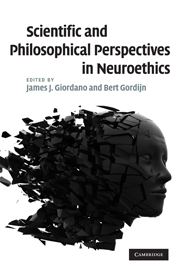Book contents
- Frontmatter
- Contents
- List of contributors
- Preface
- Acknowledgments
- Introduction
- 1 Developments in neuroscience
- 2 The origins of the modern concept of “neuroscience”
- 3 On the cusp
- 4 The mind-body issue
- 5 Personal identity and the nature of the self
- 6 Religious issues and the question of moral autonomy
- 7 Toward a cognitive neurobiology of the moral virtues
- 8 From a neurophilosophy of pain to a neuroethics of pain care
- 9 Transplantation and xenotransplantation
- 10 Neurogenetics and ethics
- 11 Neuroimaging
- 12 Can we read minds?
- 13 Possibilities, limits, and implications of brain-computer interfacing technologies
- 14 Neural engineering
- 15 Neurotechnology as a public good
- 16 Globalization: pluralist concerns and contexts
- 17 The human condition and strivings to flourish
- 18 The limits of neuro-talk
- Afterword
- Index
Afterword
Published online by Cambridge University Press: 07 May 2010
- Frontmatter
- Contents
- List of contributors
- Preface
- Acknowledgments
- Introduction
- 1 Developments in neuroscience
- 2 The origins of the modern concept of “neuroscience”
- 3 On the cusp
- 4 The mind-body issue
- 5 Personal identity and the nature of the self
- 6 Religious issues and the question of moral autonomy
- 7 Toward a cognitive neurobiology of the moral virtues
- 8 From a neurophilosophy of pain to a neuroethics of pain care
- 9 Transplantation and xenotransplantation
- 10 Neurogenetics and ethics
- 11 Neuroimaging
- 12 Can we read minds?
- 13 Possibilities, limits, and implications of brain-computer interfacing technologies
- 14 Neural engineering
- 15 Neurotechnology as a public good
- 16 Globalization: pluralist concerns and contexts
- 17 The human condition and strivings to flourish
- 18 The limits of neuro-talk
- Afterword
- Index
Summary
The past twenty years have seen remarkable progress in theoretical and clinical neuroscience. Functional neuroimaging can display realtime activation in brain regions correlating with cognitive and affective processes. Brain scans have improved the diagnosis of a range of neurological and psychiatric disorders. They can also be used to monitor the progression of these disorders and the metabolic effects of drugs used to treat them. Psychopharmacology has developed generally safer and more effective therapeutic agents for diseases of the brain and mind. Some of these agents can be used to enhance normal cognitive functions. Electrical and magnetic stimulation of the brain can control symptoms of neurological and psychiatric disorders that have not responded to other treatments. Stem-cell-based neurotransplantation in the field of restorative neurosurgery holds promise for reversing damage from neurodegenerative diseases, stroke, and spinal cord injury. Neural prostheses may enable people immobilized by paralysis to translate their intentions into actions. All of these measures and interventions in the brain have great potential to benefit a significant number of people, enabling them to become more independent and have better quality of life.
There is also a dark side to these drugs and techniques. Atypical antipsychotics can increase the risk of patients dying from sudden heart failure. Brain scans are visualizations of statistical analyses based on a large number of images and are inaccurately described as pictures of what actually occurs in the brain.
- Type
- Chapter
- Information
- Scientific and Philosophical Perspectives in Neuroethics , pp. 370 - 374Publisher: Cambridge University PressPrint publication year: 2010



